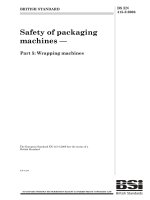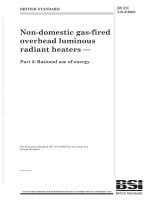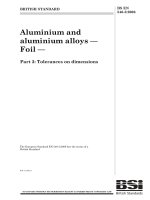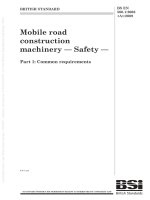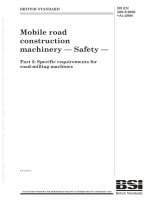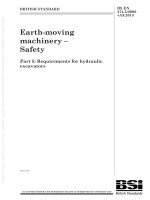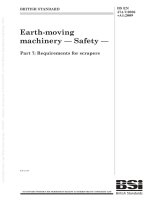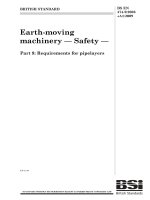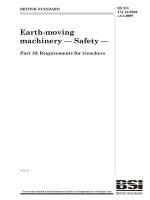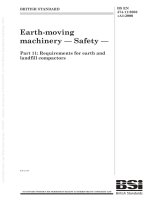Bsi bs en 62020 1999 (2006)
Bạn đang xem bản rút gọn của tài liệu. Xem và tải ngay bản đầy đủ của tài liệu tại đây (3.42 MB, 82 trang )
BRITISH STANDARD
BS EN
62020:1999
IEC
62020:1998
Incorporating
Amendment No.1
Electrical
accessories —
Residual current
monitors for
household and similar
uses (RCMs)
The European Standard EN 62020:1998, with the incorporation of amendment
A1:2005, has the status of a British Standard
ICS 29.120.50
BS EN 62020:1999
National foreword
This British Standard is the official English language version of
EN 62020:1998 including amendment A1:2005. It is identical with
IEC 62020:1998, including amendment 1:2003.
The start and finish of text introduced or altered by amendment is indicated in
the text by tags !". Tags indicating changes to IEC text carry the number
of the IEC amendment. For example, text altered by IEC amendment 1 is
indicated by !".
The CENELEC common modifications have been implemented at the
appropriate places in the text. The start and finish of each common
modification is indicated in the text by tags . Where a common
modification has been introduced by amendment, the tags carry the number of
the amendment. For example, the common modifications introduced by
CENELEC amendment A11 are indicated by ‚.
The UK participation in its preparation was entrusted by Technical Committee
ISE/NFE/4, Mechanical testing of metals, to Subcommittee ISE/NFE/4/5,
Indentation hardness testing, which has the responsibility to:
—
aid enquirers to understand the text;
—
present to the responsible international/European committee any
enquiries on the interpretation, or proposals for change, and keep UK
interests informed;
—
monitor related international and European developments and
promulgate them in the UK.
A list of organizations represented on this subcommittee can be obtained on
request to its secretary.
Cross-references
The British Standards which implement international or European
publications referred to in this document may be found in the BSI Catalogue
under the section entitled “International Standards Correspondence Index”, or
by using the “Search” facility of the BSI Electronic Catalogue or of British
Standards Online.
This publication does not purport to include all the necessary provisions of a
contract. Users are responsible for its correct application.
Compliance with a British Standard does not of itself confer immunity
from legal obligations.
Summary of pages
This document comprises a front cover, an inside front cover, the EN title page,
pages 2 to 79 and a back cover.
This British Standard, having
been prepared under the
direction of the Electrotechnical
Sector Committee was
published under the
authority of the Standards
Committee and comes into
effect on 15 January 1999
© BSI 2006
ISBN 0 580 32002 2
Amendments issued since publication
Amd. No.
Date
Comments
15841
29 September 2006
See national foreword
EUROPEAN STANDARD
EN 62020
NORME EUROPÉENNE
October 1998
EUROPÄISCHE NORM
+ A1
May 2005
ICS 29.120.50
Descriptors: Electrical household accessory, low-voltage equipment, residual current monitor, definition, characteristics,
construction, tests
English version
Electrical accessories
Residual current monitors for household
and similar uses (RCMs)
(IEC 62020:1998)
Petit appareillage électrique
Contrôleurs d’isolement à courant
différentiel résiduel (RCM) pour usages
domestiques et analogues
(CEI 62020:1998)
Elektrisches Installationsmaterial
Differenzstrom-Überwachungsgeräte
für Hausinstallationen und ähnliche
Verwendungen (RCMs)
(IEC 62020:1998)
This European Standard was approved by CENELEC on 1998-10-01.
CENELEC members are bound to comply with the CEN/CENELEC Internal
Regulations which stipulate the conditions for giving this European Standard
the status of a national standard without any alteration.
Up-to-date lists and bibliographical references concerning such national
standards may be obtained on application to the Central Secretariat or to any
CENELEC member.
This European Standard exists in three official versions (English, French,
German). A version in any other language made by translation under the
responsibility of a CENELEC member into its own language and notified to the
Central Secretariat has the same status as the official versions.
CENELEC members are the national electrotechnical committees of Austria,
Belgium, Cyprus, Czech Republic, Denmark, Estonia, Finland, France,
Germany, Greece, Hungary, Iceland, Ireland, Italy, Latvia, Lithuania,
Luxembourg, Malta, Netherlands, Norway, Poland, Portugal, Slovakia,
Slovenia, Spain, Sweden, Switzerland and United Kingdom.
CENELEC
European Committee for Electrotechnical Standardization
Comité Européen de Normalisation Electrotechnique
Europäisches Komitee für Elektrotechnische Normung
Central Secretariat: rue de Stassart 35, B-1050 Brussels
© 1998 CENELEC — All rights of exploitation in any form and by any means reserved worldwide for
CENELEC members.
Ref. No. EN 62020:1998
EN 62020:1998
Foreword
The text of document 23E/337/FDIS, future edition 1 of IEC 62020, prepared by
SC 23E, Circuit-breakers and similar equipment for household use, of IEC TC 23,
Electrical accessories, was submitted to the IEC-CENELEC parallel vote and was
approved by CENELEC as EN 62020 on 1998-10-01.
The following dates were fixed:
— latest date by which the EN has to be implemented at
national level by publication of an identical national
standard or by endorsement
— latest date by which the national standards conflicting
with the EN have to be withdrawn
(dop) 1999-07-01
(dow) 2001-07-01
Annexes designated “normative” are part of the body of the standard.
In this standard, Annex ZA is normative.
Annex ZA has been added by CENELEC.
Endorsement notice
The text of the International Standard IEC 62020:1998 was approved by
CENELEC as a European Standard without any modification.
Foreword to amendment A1
The text of document 23E/531/FDIS, future amendment 1 to IEC 62020:1998, was
prepared by SC 23E, Circuit-breakers and similar equipment for household use,
of IEC TC 23, Electrical accessories, was submitted to the IEC-CENELEC
parallel vote and was approved by CENELEC as amendment A1 to
EN 62020:1998 on 2005-03-01.
A draft amendment, aiming to improve subclause 8.18.1 of EN 62020:1998,
prepared by the Technical Committee CENELEC TC 23E, Circuit breakers and
similar devices for household and similar applications, was submitted to the
Unique Acceptance Procedure and was approved by CENELEC on 2005-03-01 for
inclusion into amendments A1 to EN 62020:1998.
The following dates were fixed:
— latest date by which the amendment has to be
implemented at national level by publication of an
identical national standard or by endorsement
— latest date by which the national standards conflicting
with the amendment have to be withdrawn
(dop) 2005-12-01
(dow) 2008-03-01
Annex ZB has been added by CENELEC.
Endorsement notice
The text of amendment 1:2003 to the International Standard IEC 62020:1998 was
approved by CENELEC as an amendment to the European Standard with agreed
common modifications.
2
© BSI 2006
BS EN 62020:1999
Contents
Page
Foreword
2
Introduction
7
1
Scope
7
2
Normative references
7
3
Definitions
8
3.1 Definitions relating to currents flowing from live parts to earth
8
3.2 Definitions relating to the energization of an RCM
9
3.3 Definitions relating to the operation and to the functions of residual
current monitors
9
3.4 Definitions relating to values and ranges of energizing quantities
10
3.5 Definitions relating to values and ranges of influencing quantities
11
3.6 Definitions relating to terminals
12
3.7 Conditions of operation
13
3.8 Test
13
4
Classification
13
4.1 According to the method of operation
13
4.2 According to the type of installation
13
4.3 According to the number of current paths
13
4.4 According to the ability to adjust the residual operating current
14
4.5 According to the possibility of adjusting the time-delay
14
4.6 According to the protection against external influences
14
4.7 According to the method of mounting
14
4.8 According to the method of connection
14
4.9 According to the type of connection of the load conductors
14
4.10 According to fault indicating means
14
4.11 According to ability to directionally discriminate between supply side
and load side residual currents
14
5
Characteristics of RCMs
15
5.1 Summary of characteristics
15
5.2 Rated quantities and other characteristics
15
5.3 Standard and preferred values
16
5.4 Coordination with short-circuit protective devices (SCPDs) (only valid
for RCMs classified according to 4.9.2)
17
6
Marking and other product information
18
7
Standard conditions for operation in service and for installation
20
7.1 Standard conditions
20
7.2 Conditions of installation
20
8
Requirements for construction and operation
20
8.1 Mechanical design
20
8.2 Protection against electric shock
24
8.3 Dielectric properties
24
8.4 Temperature rise
24
8.5 Operating characteristic
24
8.6 Directional discrimination
25
8.7 Operational endurance
25
8.8 Performance at short-circuit currents
25
8.9 Resistance to mechanical impact
25
8.10 Resistance to heat
25
8.11 Resistance to abnormal heat and to fire
25
© BSI 2006
3
EN 62020:1998
8.12
8.13
8.14
8.15
8.16
8.17
8.18
8.19
9
9.1
9.2
9.3
9.4
9.5
9.6
9.7
9.8
9.9
9.10
9.11
9.12
9.13
9.14
9.15
9.16
9.17
9.18
9.19
9.20
9.21
9.22
9.23
Test device
Correct operation of RCMs within the supply voltage range
Behaviour of RCMs in case of overcurrents in the main circuit
Resistance of RCMs to unwanted tripping due to current surges
caused by impulse voltages
Behaviour of RCMs in case of earth fault currents comprising d.c.
components
Reliability
Electromagnetic compatibility (Based on IEC 61543)
Connection of an external current transformer (CT)
Tests
General
Test conditions
Test of indelibility of marking
Test of reliability of screws, current-carrying parts and connections
Test of reliability of terminals for external conductors
Verification of protection against electric shock
Test of dielectric properties
Test of temperature rise
Verification of the operating characteristics
Verification of operational endurance
Verification of short-circuit withstand capability
Verification of resistance to mechanical impact
Test of resistance to heat
Test of resistance to abnormal heat and to fire
Verification of the operation of the test device at the limits of rated
voltage
Verification of limiting values of the non-operating current under
overcurrent conditions
Verification of resistance against unwanted operation due to current
surges caused by impulse voltages
Verification of resistance of the insulation against impulse voltages
Verification of the correct operation at residual currents with
d.c. components
Verification of reliability
Verification of ageing of electronic components
Verification of EMC requirements
Response of the RCM to temporary overvoltages on the LV-side, due
to fault conditions on the HV-side
Page
26
26
26
26
26
26
26
28
29
29
30
30
30
31
32
33
35
36
38
39
43
45
46
46
47
48
48
49
50
51
52
52
Annex A (normative) Test sequence and number of samples to be submitted
for verification of conformity to the standard
72
Annex B (normative) Determination of clearances and creepage distances
75
Annex ZA (normative) Normative references to international publications
with their corresponding European publications
77
Figure 1 — Standard test finger (9.6)
53
Figure 2a— Test circuit for the verification of the operating characteristics
for RCMs for use in TN and TT-systems
54
Figure 2b — Test circuit for the verification of directional discrimination
in IT systems for RCMs classified according to 4.11
55
Figure 3 — Test circuit for the verification of the correct operation of RCMs
in the case of residual pulsating direct currents
56
Figure 4 — Test circuit for the verification of the correct operation of RCMs in
the case of residual pulsating direct currents superimposed by smooth direct
current of 0,006 A
56
4
© BSI 2006
BS EN 62020:1999
Page
Figure 5 — Test circuit for the verification of the co-ordination with
a SCPD of a RCM with two current paths (9.11)
Figure 6 — Test circuit for the verification of the co-ordination with
a SCPD of a RCM with three current paths in a three phase circuit (9.11)
Figure 7 — Test circuit for the verification of the co-ordination with
a SCPD of a RCM with four current paths on a three-phase circuit with
neutral (9.11)
Figure 8 — Test apparatus for the verification of the minimum I2t and
Ip values to be withstood by the RCM [9.11.2.1a)]
Figure 9 — Mechanical impact test apparatus (9.12.1)
Figure 10 — Striking element for pendulum impact test apparatus (9.12.2)
Figure 11 — Mounting support for sample for mechanical impact
test (9.12.1)
Figure 12 — Example of mounting an unenclosed RCM for mechanical
impact test (9.12.1)
Figure 13 — Example of mounting of panel mounting type RCM for the
mechanical impact test (9.12.1)
Figure 14 — Application of force for mechanical test of rail-mounted
RCM (9.12.2)
Figure 15 — Ball-pressure test apparatus (9.13.2)
Figure 16 — Test circuit for the verification of the limiting value of
overcurrent in the case of single-phase load through a three-phase
RCM (9.16.2)
Figure 17 — Current ring wave 0,5 4s/100 kHz
Figure 18 — Test circuit for the ring-wave test at RCMs
Figure 19 — Stabilizing period for reliability test (9.20.1.3)
Figure 20 — Reliability test cycle (9.20.1.3)
Figure 21 — Example for test circuit for verification of ageing of electronic
components (9.21)
Figure 22a — RCMs without monitored lines connected
Figure 22b — RCMs with monitored lines connected
Figure B.1 — Illustrations of the application of creepage distances
Figure B.2 — Illustrations of the application of creepage distances
Figure B.3 — Illustrations of the application of creepage distances
Figure B.4 — Illustrations of the application of creepage distances
Figure B.5 — Illustrations of the application of creepage distances
Figure B.6 — Illustrations of the application of creepage distances
Figure B.7 — Illustrations of the application of creepage distances
Figure B.8 — Illustrations of the application of creepage distances
Figure B.9 — Illustrations of the application of creepage distances
Figure B.10 — Illustrations of the application of creepage distances
Table 1 — Standard conditions for operation in service
Table 2 — Clearances and creepage distances
Table 3 — Connectable cross-sections of copper conductors for screw-type
terminals
Table 4 — Temperature-rise values
Table Z.1 — Low frequency immunity test conditions
Table 15 — EMC Tests
Table 5 — List of type tests depending on RCM classification
Table 6 — Test copper conductors corresponding to the rated currents
Table 7 — Screw thread diameters and applied torques
Table 8 — Pulling forces
Table 9 — Conductor dimensions
© BSI 2006
57
58
59
60
61
62
62
63
64
65
65
66
67
67
68
69
70
71
71
76
76
76
76
76
76
77
77
77
77
19
21
23
25
27
28
29
29
31
32
32
5
EN 62020:1998
Table 16 — Summary of the tests contained in 9.7.2, 9.7.3 and 9.7.4
Table 11 — Silver wire diameter as a function of rated current and
short-circuit currents
Table 12 — Minimum values of I2t and Ip
Table 13 — Power factors for short-circuit tests
Table 14 — Acutating current ranges
Table A.1 — Test sequences
Table A.2 — Number of samples submitted to tests
Table A.3 — Tests with reduced number of samples
6
Page
35
41
42
42
49
72
73
74
© BSI 2006
EN 62020:1998
Introduction
The purpose of a residual current monitor (hereinafter referred to as RCM) is to monitor an electrical
installation or circuit for the presence of an unbalanced earth fault current and to indicate, by means of an
alarm, the presence of such a residual current when it exceeds a predetermined level.
An RCM may be used in conjunction with protective devices (see IEC 60364-4).
Installation and application rules are given in IEC 60364.
1 Scope
This International Standard applies to residual current monitors having rated voltages not
exceeding 440 V a.c. and rated currents not exceeding 125 A for household and similar purposes.
These devices are intended to monitor the residual current of the installation and to give a warning if the
residual current between a live part and an exposed conductive part or earth exceeds a predetermined
level.
!RCMs covered by this standard are not intended to be used as protective devices."
RCMs detect residual alternating currents and residual pulsating direct currents whether suddenly
applied or slowly rising (see 8.16).
This standard applies to monitors performing simultaneously the functions of detection of the residual
current, of comparison of the value of this current with the residual operating current of the device and of
providing the prescribed warning signal(s) when the residual current exceeds this value.
RCMs having internal batteries are not covered by this standard.
The requirements of this standard apply for normal environmental conditions (see 7.1). Additional
requirements may be necessary for RCMs used in locations having severe environmental conditions.
This standard does not cover Insulation Monitoring Devices (IMDs) which are covered by the scope of
IEC 61557-8.
NOTE An RCM is distinguished from an IMD in that it is passive in its monitoring function and only responds to an unbalanced fault
current in the installation being monitored. An IMD is active in its monitoring and measuring functions in that it can measure the
balanced and unbalanced insulation resistance or impedance in the installation (see IEC 61557-8).
2 Normative references
The following normative documents contain requirements which, through reference in this text, form an
integral part of this International Standard. At the time of publication, the editions indicated were valid.
All standards are subject to revision, and product committees using this International Standard are
encouraged to investigate the possibility of applying the most recent editions of the standards listed below.
Members of IEC and ISO maintain registers of currently valid International Standards.
IEC 60038:1983, IEC standard voltages.
IEC 60050-101:1998, International Electrotechnical Vocabulary (IEV) — Part 101: Mathematics.
IEC 60050(151):1978, International Electrotechnical Vocabulary (IEV) — Chapter 151: Electrical and
magnetic devices.
IEC 60050(441):1984, International Electrotechnical Vocabulary (IEV) — Chapter 441: Switchgear,
controlgear and fuses.
IEC 60051 (all parts), Direct acting indicating analogue electrical measuring instruments and their
accessories.
IEC 60068-2-28:1990, Environmental testing — Part 2: Tests — Guidance for damp heat tests.
IEC 60068-2-30:1980, Environmental testing — Part 2: Tests — Test Db and guidance: Damp heat,
cyclic (12 + 12-hour cycle).
IEC 60364-4-443:1995, Electrical installations of buildings — Part 4: Protection for safety —
Chapter 44: Protection against overvoltages —Section 443: Protection against overvoltages of atmospheric
origin or due to switching.
© BSI 2006
7
EN 62020:1998
IEC 60364-5-53:1994, Electrical installations of buildings — Part 5: Selection and erection of electrical
equipment — Chapter 53: Switchgear and controlgear.
IEC 60417-2:1998, Graphical symbols for use on equipment — Part 2: Symbol originals.
IEC 60529:1989, Degrees of protection provided by enclosures (IP Code).
IEC 60664-1:1992, Insulation coordination for equipment within low-voltage systems — Part 1: Principles,
requirements and tests.
!IEC 60664-3:2003, Insulation coordination for equipment within low-voltage systems — Part 3: Use of
coating, potting or moulding for protection against pollution".
IEC 60695-2-1/0:1994, Fire hazard testing — Part 2: Test methods —
Section 1/sheet 0: Glow-wire test methods — General.
IEC 60755:1983, General requirements for residual current operated protective devices.
IEC 61008-1:1996, Residual current operated circuit-breakers without integral overcurrent protection for
household and similar uses (RCCBs) — Part 1: General rules.
IEC 61543:1995, Residual current-operated protective devices (RCDs) for household and similar use —
Electromagnetic compatibility.
IEC 61557-8:1997, Electrical safety in low-voltage distribution systems up to 1 000 V a.c.
and 1 500 V d.c. — Equipment for testing, measuring or monitoring of protective
measures — Part 8: Insulation monitoring devices for IT systems.
ISO/IEC Guide 2:1991, General terms and their definitions concerning standardization and related
activities.
!CISPR 14-1:2002, Electromagnetic compatibility — Requirements for household appliances, electric
tools and similar apparatus — Part 1: Emission".
3 Definitions
For the purpose of this standard, the following definitions apply.
Where the terms “voltage” or “current” are used, they imply r.m.s. values, unless otherwise specified.
3.1 Definitions relating to currents flowing from live parts to earth
3.1.1
earth fault current
current flowing to earth due to an insulation fault
3.1.2
earth leakage current
current flowing from the live parts of the installation to earth in the absence of an insulation fault
3.1.3
pulsating direct current
current of pulsating wave form (IEV 101-14-31) which assumes, in each period of the rated power
frequency, the value 0 or a value not exceeding 0,006 A d.c. during one single interval of time, expressed in
angular measure, of at least 150°
3.1.4
current delay angle µ
time, expressed in angular measure, by which the starting instant of current conduction is delayed by
phase control
8
© BSI 2006
EN 62020:1998
3.2 Definitions relating to the energization of an RCM
3.2.1
energizing quantity
electrical excitation quantity which alone, or in combination with other such quantities, shall be applied to
a RCM to enable it to accomplish its function under specified conditions
3.2.2
energizing input-quantity
energizing quantity by which the RCM is activated when it is applied under specified conditions these
conditions may involve, for example, the energizing of certain auxiliary elements
3.2.3
residual current (I%)
vector sum of the instantaneous values of the current flowing in the main circuit of the RCM (expressed as
r.m.s. value)
3.2.4
residual operating current
value of residual current which causes the RCM to operate under specified conditions
3.2.5
residual non-operating current (I%no)
value of residual current at which and below which the RCM does not operate under specified conditions
3.3 Definitions relating to the operation and to the functions of residual current monitors
3.3.1
residual current monitor (RCM)
device or association of devices which monitors the residual current in an electrical installation, and which
activates an alarm when the residual current exceeds the operating value of the device
3.3.2
RCMs functionally independent of line voltage
RCMs for which the functions of detection, evaluation and actuation do not depend on the line voltage
3.3.3
RCMs functionally dependent on line voltage
RCMs for which the functions of detection, evaluation or actuation depend on the line voltage
NOTE It is understood that the line voltage is applied to RCMs for detection, evaluation or actuation.
3.3.4
limiting non-actuating time
maximum delay during which a value of residual current higher than the residual !operating" current
can be applied to the RCM without causing it to operate
3.3.5
time-delay RCM
RCM specially designed to attain a predetermined value of limiting non-actuating time, corresponding to
a given value of residual current
3.3.6
main circuit (of a RCM)
all the conductive parts of a RCM included in the current paths (see 4.3)
3.3.7
control and auxiliary circuit (of a RCM)
all the conductive parts of a RCM intended to be included in a circuit other than the main circuit of the RCM
NOTE The circuits intended for the test device are included in this definition.
© BSI 2006
9
EN 62020:1998
3.3.8
RCM type A
RCM for which actuation is ensured for residual sinusoidal alternating currents and residual pulsating
direct currents, whether suddenly applied or slowly rising
3.3.9
test device
device incorporated in the RCM simulating the residual current conditions for the operation of the RCM
under specified conditions
3.3.10
alarm state
alarm state indicates that the residual current in the installation monitored has exceeded the preset level
of the RCM
3.3.11
non-alarm state
non-alarm state indicates that the residual current in the installation monitored is less than the preset
level of the RCM
3.3.12
actuating time
time taken for an RCM to change from the non-alarm state to the alarm state in response to the sudden
appearance of a residual current which exceeds the preset level
!3.3.13
functional earth connection (FE)
electrical connection between RCM and earth which is provided to ensure:
— a reference point for RCMs having a discriminating function (see 4.11) and/or
— continued operation in the event of loss of supply neutral.
3.3.14 maximum actuating time (Tmax)
the maximum actuating time for residual currents greater than or equal to I%n for RCMs with adjustable
time delay
3.3.15 minimum non-actuating time (Tmin)
the minimum non-actuating time for residual currents greater than or equal to I%n for RCMs with
adjustable time delay"
3.4 Definitions relating to values and ranges of energizing quantities
3.4.1
rated value
quantity value assigned by the manufacturer for a specific operating condition of a RCM
3.4.2
non-operating overcurrents in the main circuit
definitions of limiting values of non-operating overcurrents are given in 3.4.2.1 and 3.4.2.2
NOTE In the case of overcurrent in the main circuit, in the absence of residual current, operation of the detecting device may occur
as a consequence of asymmetry existing in the detecting device itself.
3.4.2.1
limiting value of overcurrent in case of a load through a RCM with two current paths
maximum value of overcurrent of a load which, in the absence of any fault to frame or to earth, and in the
absence of an earth leakage current, can flow through a RCM with two current paths without causing it to
operate
10
© BSI 2006
EN 62020:1998
3.4.2.2
limiting value of overcurrent in case of a single-phase load through a RCM
maximum value of a single-phase overcurrent which in the absence of any fault to frame or to earth, and
in the absence of an earth leakage current, can flow through a RCM without causing it to switch to the
alarm state
3.4.3
residual short-circuit withstand current
maximum value of the residual current for which the operation of the RCM is ensured under specified
conditions and above which the device may undergo irreversible alterations
3.4.4
prospective current
current that would flow in the circuit, if each main current path of the RCM and of the overcurrent
protective device (if any) were replaced by a conductor of negligible impedance
NOTE The prospective current may be qualified in the same manner as an actual current, for example: prospective breaking current,
prospective peak current, prospective residual current.
3.4.5
conditional short-circuit current
value of the a.c. component of a prospective current, which a RCM protected by a suitable short-circuit
protective device (hereafter referred to as SCPD) in series can withstand under specified conditions of use
and behaviour
3.4.6
conditional residual short-circuit current
value of the a.c. component of a residual prospective current which a RCM protected by a suitable SCPD in
series, can withstand under specified conditions of use and behaviour
3.4.7
I2t (Joule integral)
the integral of the square of the current over a given time interval (t0,t1):
3.5 Definitions relating to values and ranges of influencing quantities
3.5.1
influencing quantity
any quantity likely to modify the specified operation of a RCM
3.5.2
reference value of an influencing quantity
value of an influencing quantity to which the manufacturer’s stated characteristics are referred
3.5.3
reference conditions of influencing quantities
collectively, the reference values of all influencing quantities
3.5.4
range of an influencing quantity
range of values of an influencing quantity which permits the RCM to operate under specified conditions,
the other influencing quantities having their reference values
3.5.5
extreme range of an influencing quantity
range of values of an influencing quantity within which the RCM suffers only spontaneously reversible
changes, although not necessarily complying with all the requirements of this standard
© BSI 2006
11
EN 62020:1998
3.5.6
ambient air temperature
temperature, determined under prescribed conditions of the air surrounding the RCM (for an enclosed
RCM it is the air outside the enclosure)
3.6 Definitions relating to terminals
3.6.1
terminal
conductive part of a device, provided for reusable electrical connection to external circuits
NOTE For examples of designs of terminals, see informative Annex IC in IEC 61008-1.
3.6.2
screw-type terminal
terminal for the connection and subsequent disconnection of one conductor or the interconnection of two or
more conductors capable of being dismantled, the connections being made, directly or indirectly, by means
of screws or nuts of any kind
3.6.3
pillar terminal
screw-type terminal in which the conductor is inserted into a hole or cavity, where it is clamped under the
shank of the screw(s). The clamping pressure may be applied directly by the shank of the screw or through
an intermediate clamping element to which pressure is applied by the shank of the screw
3.6.4
screw terminal
screw-type terminal in which the conductor is clamped under the head of the screw. The clamping pressure
may be applied directly by the head of the screw or through an intermediate part, such as a washer, a
clamping plate or an anti-spread device
3.6.5
stud terminal
screw-type terminal in which the conductor is clamped under a nut. The clamping pressure may be applied
directly by a suitably shaped nut or through an intermediate part, such as a washer, a clamping plate or
an anti-spread device
3.6.6
saddle terminal
screw-type terminal in which the conductor is clamped under a saddle by means of two or more screws
or nuts
3.6.7
lug terminal
screw terminal or a stud terminal, designed for clamping a cable lug or a bar by means of a screw or nut
3.6.8
screwless terminal
connecting terminal for the connection and subsequent disconnection of one conductor or the dismountable
interconnection of two or more conductors capable of being dismantled, the connection being made, directly
or indirectly, by means of springs, wedges, eccentrics or cones, etc., without special preparation of the
conductor other than removal of insulation
3.6.9
tapping screw
screw manufactured from a material having high resistance to deformation, when applied by rotary
insertion to a hole in a material having less resistance to deformation than the screw. The screw is made
with a tapered thread, the taper being applied to the core diameter of the thread at the end section of the
screw. The thread produced by application of the screw is formed securely only after sufficient revolutions
have been made to exceed the number of threads on the tapered section
12
© BSI 2006
EN 62020:1998
3.6.10
thread forming screw
tapping screw having an uninterrupted thread; it is not a function of this thread to remove material from
the hole
3.6.11
thread cutting screw
tapping screw having an interrupted thread; it is a function of this thread to remove material from the hole
3.7 Conditions of operation
3.7.1
operation
alteration of the state of the RCM from the non-alarm state to the alarm state or vice versa
3.7.2
clearance (see Annex B)
shortest distance in air between two conductive parts
NOTE For the purpose of determining a clearance to accessible parts, the accessible surface of insulating enclosure shall be
considered conductive as if it was covered by a metal foil wherever it can be touched by hand or by the standard test finger according
to Figure 1.
3.7.3
creepage distance (see Annex B)
shortest distance along the surface of an insulating material between two conductive parts
NOTE For the purpose of determining a creepage distance to accessible parts, the accessible surface of insulating enclosure shall be
considered conductive as if it was covered by a metal foil wherever it can be touched by hand or by a standard test finger according to
Figure 1.
3.8 Test
3.8.1
type test
test of one or more devices made to a certain design to show that the design meets certain requirements
3.8.2
routine tests
test to which each individual device is subjected during and/or after manufacture to ascertain whether it
complies with certain criteria
4 Classification
RCMs are classified:
4.1 According to the method of operation
4.1.1 RCM functionally dependent on line voltage
4.1.2 RCM functionally dependent on an energy source other than line voltage
4.2 According to the type of installation
— RCM for fixed installation and fixed wiring;
— RCM for mobile installation and corded connection (of the device itself to the supply).
4.3 According to the number of current paths
— two current paths RCM;
— three current paths RCM;
— four current paths RCM.
© BSI 2006
13
EN 62020:1998
4.4 According to the ability to adjust the residual operating current
— RCM with a non-adjustable residual operating current;
NOTE Some RCMs with non-adjustable residual operating current may include a pre-warning level.
— RCM with adjustable residual operating current.
4.5 According to the possibility of adjusting the time-delay
— RCM without adjustable time-delay;
— RCM with adjustable time-delay.
4.6 According to the protection against external influences
— enclosed-type RCM (not requiring an appropriate enclosure);
— unenclosed-type RCM (for use with an appropriate enclosure).
4.7 According to the method of mounting
— surface-type RCM;
— flush-type RCM;
— panel board type RCM, also referred to as distribution board type.
NOTE These types may be intended to be mounted on rails.
4.8 According to the method of connection
— RCMs the connections of which are not associated with the mechanical mounting;
— RCMs the connections of which are associated with the mechanical mounting, for example:
plug-in type, bolt-on type.
NOTE Some RCMs may be of the plug-in type or bolt-on type on the line side only, the load terminals being usually suitable for
wiring connection.
4.9 According to the type of connection of the load conductors
!4.9.1 RCM to which the monitored line is not directly connected
See Figure 22a.
4.9.2 RCM to which the monitored line is directly connected
See Figure 22b."
4.10 According to fault indicating means
— visual, non-resettable during fault condition (minimum requirement);
— visual and audible; the audible means may be disabled by the user during fault condition;
— visual, with relay output; the relay may be disabled by the user during fault condition;
— visual, with other output signal.
4.11 According to ability to directionally discriminate between supply side and load side
residual currents
— directionally discriminating (applicable in IT systems);
— directionally non-discriminating.
14
© BSI 2006
EN 62020:1998
5 Characteristics of RCMs
5.1 Summary of characteristics
The characteristics of a RCM shall be stated in the following terms:
— type of installation (see 4.2);
— number of current paths (see 4.3);
— rated current In (see 5.2.2);
— rated residual operating current I%n (see 5.2.3);
— rated residual non-operating current I%no (see 5.2.4);
— rated voltage Un (see 5.2.1);
— rated frequency (see 5.2.5);
— time-delay, if applicable;
— operating characteristics in case of residual currents with d.c. components (see 5.2.6);
— insulation coordination including clearances and creepage distances (see 5.2.7);
— degree of protection (see IEC 60529);
— rated conditional short-circuit current Inc (only for RCMs according to 4.9.2);
— rated conditional residual short-circuit current I%c (only for RCMs according to 4.9.2);
— behaviour of the RCM in case of failure of the line voltage (see 4.1.1);
— behaviour of the RCM in case of failure of the energy source other than the line voltage (see 4.1.2).
5.2 Rated quantities and other characteristics
5.2.1 Rated voltage
5.2.1.1 Rated operational voltage (Ue)
The rated operational voltage (hereafter referred to as rated voltage Un) of a RCM is the value of voltage,
assigned by the manufacturer, to which its performance is referred.
NOTE The same RCM may be assigned a number of rated voltages.
5.2.1.2 Rated insulation voltage (Ui)
The rated insulation voltage of a RCM is the value of voltage, assigned by the manufacturer, to which
dielectric test voltages and creepage distances are referred.
Unless otherwise stated, the rated insulation voltage is the value of the maximum rated voltage of the
RCM. In no case shall the maximum rated voltage exceed the rated insulation voltage.
5.2.2 Rated current (In)
The value of current, assigned to the RCM by the manufacturer, which the RCM can carry in uninterrupted
duty. !Text deleted"
5.2.3 Rated residual operating current (I%n)
The value of residual operating current (see 3.2.4), assigned to the RCM by the manufacturer, at which the
RCM shall operate under specified conditions.
NOTE For a RCM having multiple settings of residual operating current the highest setting is used to designate it.
5.2.4 Rated residual non-operating current (I%no)
The value of residual non-operating current (see 3.2.5), assigned to the RCM by the manufacturer, at which
the RCM does not operate under specified conditions.
5.2.5 Rated frequency
The power frequency for which the RCM is designed and to which the values of the other characteristics
correspond.
NOTE The same RCM may be assigned a number of rated frequencies.
© BSI 2006
15
EN 62020:1998
5.2.6 Operating characteristics in case of residual currents with d.c. components
Actuation is ensured by RCM for residual sinusoidal alternating currents and residual pulsating direct
currents, whether suddenly applied or slowly rising.
NOTE This operating characteristic corresponds to type A of IEC 61008-1.
5.2.7 Insulation coordination including clearances and creepage distances
Under consideration.
NOTE For the time being clearances and creepage distances are given in 8.1.3.
5.3 Standard and preferred values
5.3.1 Preferred values of rated voltage (Un)
The voltages 230 V and 400 V are standardized according to IEC 60038. These values shall progressively
replace the values 220 V and 240 V, 380 V and 415 V, respectively.
Wherever in this standard there is a reference to 230 V and 400 V, they may be read as 220 V
or 240 V, 380 V or 415 V, respectively.
For single-phase three-wire systems the standardized voltages are 120/240 V.
5.3.2 Preferred values of rated current (In)
Preferred values of rated current are (only for RCMs according to 4.9.2)
10 – 13 – 16 – 20 – 25 – 32 – 40 – 63 – 80 – 100 –125 A.
NOTE For RCMs according to 4.9.1 the rated current is limited by the physical size of the current transformer, external or internal
to the RCM itself.
5.3.3 Preferred values of rated residual operating current (I%n)
!Preferred" values of rated residual operating current are
0,006 – 0,01 – 0,03 – 0,1 – 0,3 – 0,5 A.
In case of RCMs having multiple settings of residual operating current the rating refers to the highest
setting.
!Note deleted"
5.3.4 Standard value of residual non-operating current (I%no)
The standard value of residual non-operating current is 0,5 I%n.
NOTE For residual pulsating direct currents residual
non-operating currents depend on the current delay angle µ (see 3.1.4).
5.3.5 Standard minimum value of
non-operating overcurrent in case of a multiphase balanced load through a multipath RCM
(see 3.4.2.1)
The standard minimum value of the non-operating current in case of a multiphase balanced load through
a multipath RCM is 6 In.
5.3.6 Standard minimum value of the
non-operating overcurrent through a RCM (see 3.4.2.2)
The standard minimum value of the non-operating overcurrent through a RCM is 6 In.
This clause does not apply to RCMs classified according to 4.9.1. The minimum value of the
non-operating overcurrent through a RCM classified according to 4.9.1 shall be taken into account to
declare the rated current (see note to 5.3.2). For this purpose RCMs according to 4.9.1 with adjustable
residual operating current shall be set at the lowest value appropriate to each current transformer.
16
© BSI 2006
EN 62020:1998
5.3.7 Preferred values of rated frequency
Preferred values of rated frequency are 50 Hz and/or 60 Hz.
If another value is used, the rated frequency shall be marked on the device and the tests carried out at this
frequency.
5.3.8 Standard and preferred values of the rated conditional short-circuit current (Inc) (only
applicable to RCMs classified according to 4.9.2)
5.3.8.1 Values up to and including 10 000 A
Up to and including 10 000 A the values of the rated conditional short-circuit current Inc are standard.
They are:
3 000 – 4 500 – 6 000 – 10 000 A.
The associated power factors are specified in Table 13.
5.3.8.2 Values above 10 000 A
For values above 10 000 A up to and including 25 000 A a preferred value is 20 000 A.
The associated power factors are specified in Table 13.
Values above 25 000 A are not considered in this standard.
5.3.9 Maximum actuating time (Tmax)
The actuating time for residual currents equal to or greater than I%n shall not exceed 10 s.
!5.3.10 Minimum non-actuating time (Tmin)
For RCMs with minimum non-actuating time according to 3.3.15, this time shall be declared by the
manufacturer."
5.4 Coordination with short-circuit protective devices (SCPDs) (only valid for RCMs classified
according to 4.9.2)
5.4.1 General
RCMs shall be protected against short-circuits by means of circuit-breakers or fuses complying with their
relevant standards according to the installation rules of IEC 60364.
Coordination between RCMs and the SCPD shall be verified under the general conditions of 9.11.2.1, by
means of the tests described in 9.11.2.2 which are designed to verify that there is an adequate protection
of the RCMs against short-circuit currents up to the conditional short-circuit current Inc and up to the
conditional residual short-circuit current I%c.
5.4.2 Rated conditional short-circuit current (Inc)
The r.m.s. value of prospective current, assigned by the manufacturer, which a RCM, protected by a SCPD,
can withstand under specified conditions without undergoing alterations impairing its functions.
The conditions are those specified in 9.11.2.2 a).
5.4.3 Rated conditional residual short-circuit current (I%c)
The value of residual prospective current, assigned by the manufacturer, which a RCM, protected by a
SCPD, can withstand under specified conditions without undergoing alterations impairing its functions.
The conditions are those specified in 9.11.2.2 b).
© BSI 2006
17
EN 62020:1998
6 Marking and other product information
!Each RCM and external devices of RCMs, if applicable, shall be marked in a durable manner with the
following data:"
a) the manufacturer’s name or trade mark;
b) type designation, catalogue number or serial number;
c) rated voltage(s);
d) rated frequency, if the RCM is designed for frequencies other than 50 Hz and/or 60 Hz (see 5.3.7);
e) rated current;
f) rated residual operating current;
g) settings of residual operating current in case of RCMs with multiple residual operating current
settings;
h) the degree of protection (only if different from IP20);
j) the position of use (symbol according to IEC 60051), if necessary;
k) operating means of the test device, by the letter T;
l) wiring diagram;
m) operating characteristic in presence of residual currents with d.c. components with
the symbol:
n) disabling means for the audible signal, by the symbol:
o) installation instructions, including identification of current transformer(s) which may be used with
the RCM;
p) directionally discriminating RCM by the symbol:
!q) the maximum actuating time (see 5.3.9);
r) the minimum non-actuating time (see 5.3.10);
s) the FE-terminal shall be marked “FE”.
If, for small devices, the space available does not allow all the above data to be marked, at least the
information under e), f), k) and, as applicable, o) and p) shall be marked and visible when the device is
installed. The remaining information shall be given in the manufacturer’s catalogues."
The marking shall be on the RCM itself or on a nameplate or nameplates attached to the RCM and shall
be located so that it is legible when the RCM is installed.
18
© BSI 2006
EN 62020:1998
Table 1 — Standard conditions for operation in service
Influencing quantity
Standard range of application
Reference value
Test
tolerancesf
20 °C
± 5 °C
Not exceeding 5 times the earth’s
magnetic field in any direction
Earth’s magnetic
field
d
Position
As stated by the manufacturer, with
a tolerance of 2° in any directione
As stated by the
manufacturer
2° in any
direction
Frequency
Reference value ± 5 %
Rated value
±2%
Sinusoidal wave distortion
Not exceeding 5 %
Zero
5%
Ambient temperature ag
– 5 °C to + 40 °Cb
Altitude
Not exceeding 2 000 m
Relative humidity maximum
value at 40 °C
50 %c
External magnetic field
a The
maximum value of the mean daily temperature is + 35 °C.
b
Values outside the range are admissible where more severe climatic conditions prevail, subject to agreement between
manufacturer and user.
c Higher
d
relative humidities are admitted at lower temperature (for example 90 % at 20 °C).
When a RCM is installed in proximity of a strong magnetic field, supplementary requirements may be necessary.
e
The device shall be fixed without causing deformation liable to impair its functions.
f
The tolerances given apply unless otherwise specified in the relevant test.
g
Extreme limits of – 20 °C and + 60 °C are admissible during storage and transportation, and should be taken into account in the
design of the device.
Additional components, e.g. separate warning units, shall be marked according to a), b), c), d) and n) (if
applicable).
If, for small devices, the space available does not allow all the above data to be marked, at least the
information under e), f), k) and n) shall be marked and visible when the device is installed. The information
under a), b), c), j), l) and p) may be marked on the side or on the back of the device and be visible only before
the device is installed. Alternatively the information under l) may be on the inside of any cover which has
to be removed in order to connect the supply wires. Any remaining information not marked shall be given
in the manufacturer’s catalogue.
The manufacturer shall give the reference of one or more suitable SCPDs in his catalogues and in a sheet
accompanying each RCM classified under 4.9.2.
Red shall not be used for the test button nor for the resetting means, if any, of the RCM.
If it is necessary to distinguish between the supply and the load terminals, they shall be clearly marked
(e.g. by “line” and “load” placed near the corresponding terminals or by arrows indicating the direction of
power flow).
Terminals on the RCM for connecting the current transformer shall be clearly identified.
Terminals exclusively intended for the connection of the neutral conductor shall be indicated by the
letter N.
Terminals intended for the protective conductor, if any, shall be indicated by the symbol
[IEC 60417-2-5019 a)].
NOTE The symbol
[IEC 60417-2-5017 a)], previously recommended, shall be progressively superseded by the preferred
symbol IEC 60417-2-5019 a), given above.
The marking shall be indelible, easily legible and not be placed on screws, washers or other removable
parts.
Compliance is checked by inspection and by the test of 9.3.
© BSI 2006
19
EN 62020:1998
7 Standard conditions for operation in service and for installation
7.1 Standard conditions
RCMs complying with this standard shall be capable of operating under the standard conditions shown in
Table 1.
7.2 Conditions of installation
RCMs shall be installed in accordance with the manufacturer’s instructions.
8 Requirements for construction and operation
8.1 Mechanical design
8.1.1 General
A RCM may provide for remote indication of the fault condition.
It shall not be possible to alter the operating characteristics of the RCM by means of external interventions
other than those specifically intended for changing the setting of the residual operating current or the time
delay.
Where RCMs are fitted with an internal current transformer (CT), but have the capability of selecting an
optional external CT, all relevant tests shall be carried out using the internal CT. The proper function of
the external CT shall, however, be confirmed by testing it once according to 9.9.4.
8.1.2 Features
!The RCM shall be provided with a visual “Power on” indicator which shall neither be red, yellow nor
blue."
The RCM shall be provided with means for indicating a fault condition when the residual current exceeds
the preset operating value, the primary indicating means being visual. The visual indicating means shall
be an integral part of the RCM and shall be easily discernible from the front of the RCM when installed as
for normal use. This visual indicating means shall not be coloured green. It shall not be possible to override
the visual alarm whilst the fault is present.
NOTE A visual alarm may also be part of a remote alarm unit, where it shall be clearly visible when installed.
Where an audible alarm is provided in addition, the audible signal shall be easily perceptible by persons
with normal hearing and may have adjustable sound level. It is permissible to switch off the audible alarm
whilst the fault is present.
The audible alarm, if any, shall be automatically self-resetting on removal of the fault. In the event of a
subsequent fault following removal of the first fault, the audible alarm shall be reactivated.
RCMs may be fitted with a resetting means to manually reset the RCM to the non-alarm state after
removal of the fault. RCMs not fitted with a resetting means shall reset automatically after removal of the
fault.
Where means are provided for adjustment of the residual operating current or of the delay time, such
adjustment shall only be possible by the use of a tool.
Compliance with the above paragraphs is checked by inspection during the tests according to 9.9.
!8.1.3 Clearances and creepage distances (see also Annex B)
Clearance and creepage distances applicable to the RCM and its external components, e.g. current
transformers etc., with the exception of printed circuit boards, shall comply with the requirements of
Table 2 when the RCM is mounted as for normal use.
The above requirements shall also apply to active conductors (phases and neutral) connected directly to the
printed circuit board.
Creepage distances applicable to printed circuit boards of the RCM shall comply with the requirements of
Table 4 of IEC 60664-1, “Creepage distances to avoid failure due to tracking”, Pollution degree 2, Material
group III.
Table 4 of IEC 60664-1 includes requirements for uncoated printed circuit boards. IEC 60664-3 provides
for reduced clearance and creepage distances for printed circuit boards using a protective coating, potting
or moulding. Such printed circuit boards may therefore be verified for compliance in accordance with
IEC 60664-3 instead of Table 4 or IEC 60664-1."
20
© BSI 2006
EN 62020:1998
Table 2 — Clearances and creepage distances
Description
Clearancesa
— between live parts of different polaritybc
— between live parts and
• metal resetting means
• metal test button
• screws or other means for fixing covers which have to be removed when mounting the RCM
• the surface on which the base is mountedd
• screws or other means for fixing the RCMd
• metal covers or boxesd
• other accessible metal partse
• metal frames supporting flush-type RCMs
Creepage distancesa
— between live parts of different polaritybc
• for RCMs having a rated voltage not exceeding 250 V
• for other RCMs
— between live parts and
• metal resetting means
• metal test button
• screws or other means for fixing covers which have to be removed when mounting the RCM
• screws or other means for fixing the RCMsd
• accessible metal partse
Distance
mm
3
3
3
3
6 (3)
6 (3)
6 (3)
3
3
3
4
3
3
3
6 (3)
3
a
Clearances and creepage distances of the secondary circuit and between the primary windings of the RCM transformer are not
considered.
b
Care should be taken for providing adequate spacing between live parts of different polarity of RCMs of the plug-in type mounted
close to one another. Values are under consideration.
c
In some countries greater distances between terminals are used in accordance with national practices.
d
If clearances and creepage distances between live parts of the device and the metallic screen or the surface on which the RCM is
mounted are dependent on the design of the RCM only, so that they cannot be reduced when the RCM is mounted in the most
unfavourable position (even in a metallic enclosure), the values in brackets are sufficient.
e
Including a metal foil in contact with the surfaces of insulating material which are accessible after installation as for normal use.
The foil is pushed into corners, grooves, etc., by means of a straight jointed test finger according to 9.6.
8.1.4 Screws, current-carrying parts and connections
8.1.4.1 Connections, whether electrical or mechanical, shall withstand the mechanical stresses occurring
in normal use.
Screws operated when mounting the RCM during installation shall not be of the thread-cutting type.
NOTE 1 Screws (or nuts) which are operated when mounting the RCM include screws for fixing covers or cover-plates, but not
connecting means for screwed conduits and for fixing the base of a RCM.
Compliance is checked by inspection and by the test of 9.4.
NOTE 2 Screwed connections are considered as checked by the tests of 9.8, 9.11, 9.12, 9.13 and 9.21.
8.1.4.2 For screws in engagement with a thread of insulating material and which are operated when
mounting the RCM during installation, correct introduction of the screw into the screw hole or nut shall be
ensured.
Compliance is checked by inspection and by manual test.
NOTE The requirement with regard to correct introduction is met if introduction of the screw in a slanting manner is prevented, for
example, by guiding the screw by the part to be fixed by a recess in the female thread or by the use of a screw with the leading thread
removed.
© BSI 2006
21
EN 62020:1998
8.1.4.3 Electrical connections shall be so designed that contact pressure is not transmitted through
insulating material other than ceramic, pure mica or other material with characteristics no less suitable,
unless there is sufficient resilience in the metallic parts to compensate for any possible shrinkage or
yielding of the insulating material.
Compliance is checked by inspection.
NOTE The suitability of the material is considered with respect to the stability of the dimensions.
8.1.4.4 Current-carrying parts including parts intended for protective conductors, if any, shall be of
— copper;
— an alloy containing at least 58 % copper for parts worked cold, or at least 50 % copper for other
parts;
— other metal or suitably coated metal, no less resistant to corrosion than copper and having mechanical
properties no less suitable.
NOTE New requirements and appropriate tests for determining the resistance to corrosion are under consideration. These
requirements should permit other materials to be used if suitably coated.
The requirements of this subclause do not apply to contacts, magnetic circuits, heater elements, bimetals,
shunts, parts of electronic devices or to screws, nuts, washers, clamping plates, similar parts of terminals
and parts of the test circuit.
8.1.5 Terminals for external conductors
8.1.5.1 Terminals for external conductors shall be such that the conductors may be connected so as to
ensure that the necessary contact pressure is maintained permanently.
In this standard, screw-type terminals for external copper conductors only are considered.
NOTE Requirements for flat quick-connect terminations, screwless terminals and terminals for the connection of aluminium
conductors are under consideration.
Connection arrangements intended for busbar connection are admissible, provided they are not used for
the connection of cables.
Such arrangements may be either of the plug-in or of the bolt-on type.
The terminals shall be readily accessible under the intended conditions of use.
Compliance is checked by inspection and by the tests of 9.5.
8.1.5.2 RCMs according to classification 4.9.2 shall be provided with terminals which shall allow the
connection of copper conductors having nominal cross-sectional areas as shown in Table 3.
NOTE For conductors of signalling circuits smaller cross-sections and smaller terminals are permitted.
Compliance is checked by inspection, by measurement and by fitting in turn one conductor of the smallest
and one of the largest cross-sectional area as specified.
8.1.5.3 The means for clamping the conductors in the terminals shall not serve to fix any other component,
although they may hold the terminals in place or prevent them from turning.
Compliance is checked by inspection and by the tests of 9.5.
8.1.5.4 Terminals for rated currents up to and including 32 A shall allow the conductors to be connected
without special preparation.
Compliance is checked by inspection.
NOTE The term “special preparation” covers soldering of wires of the conductor, use of cable lugs, formation of eyelets, etc., but not
the reshaping of the conductor before its introduction into the terminal or the twisting of a flexible conductor to consolidate the end.
8.1.5.5 Terminals shall have adequate mechanical strength.
Screws and nuts for clamping the conductors shall have a metric ISO thread or a thread comparable in
pitch and mechanical strength.
Compliance is checked by inspection and by the tests of 9.4 and 9.5.1.
22
© BSI 2006
EN 62020:1998
Table 3 — Connectable cross-sections of copper conductors for screw-type terminals
Range of nominal cross-section to be clampeda
mm2
Rated current
A
Greater than
—
13
16
25
32
50
80
100
Up to and including
13
16
25
32
50
80
100
125
Rigid (solid or stranded)
conductors
1
1
1,5
2,5
4
10
16
24
to
to
to
to
to
to
to
to
2,5
4
6
10
16
25
35
50
Flexible conductors
1
1
1,5
2,5
4
10
16
24
to
to
to
to
to
to
to
to
2,5
4
6
6
10
16
25
35
NOTE For correspondence between ISO and AWG cross-sections see Annex ID of IEC 61008-1.
a
It is required that, for current ratings up to and including 50 A, terminals be designed to clamp solid conductors as well as rigid
stranded conductors. Nevertheless, it is permitted that terminals for conductors having cross-sections from 1 mm2 up to 6 mm2 be
designed to clamp solid conductors only.
8.1.5.6 Terminals shall be so designed that they clamp the conductor without undue damage to the
conductor.
Compliance is checked by inspection and by the test of 9.5.2.
8.1.5.7 Terminals shall be so designed that they clamp the conductor reliably and between metal surfaces.
Compliance is checked by inspection and by the tests of 9.4 and 9.5.2.
8.1.5.8 Terminals shall be so designed or positioned that neither a rigid solid conductor nor a wire of a
stranded conductor can slip out while the clamping screws or nuts are tightened.
This requirement does not apply to lug terminals.
Compliance is checked by the test of 9.5.3.
8.1.5.9 Terminals shall be so fixed or located that, when the clamping screws or nuts are tightened or
loosened, their fixings do not work loose.
These requirements do not imply that the terminals shall be so designed that their rotation or displacement
is prevented, but any movement shall be sufficiently limited so as to prevent
non-compliance with the requirements of this standard.
The use of sealing compound or resin is considered to be sufficient for preventing a terminal from working
loose, provided that
— the sealing compound or resin is not subject to stress during normal use;
— the effectiveness of the sealing compound or resin is not impaired by temperatures attained by the
terminal under the most unfavourable conditions specified in this standard.
Compliance is checked by inspection, by measurement, and by the test of 9.4.
8.1.5.10 Clamping screws or nuts of terminals intended for the connection of protective conductors shall be
adequately secured against accidental loosening and it shall not be possible to unclamp them without a
tool.
Compliance is checked by manual test.
In general, common designs of terminals provide sufficient resilience to comply with this requirement; for
some designs special provisions, such as the use of an adequately resilient part which is not likely to be
removed inadvertently, may be necessary.
8.1.5.11 Screws and nuts of terminals intended for the connection of external conductors shall be in
engagement with a metal thread and the screws shall not be of the tapping screw type.
© BSI 2006
23
